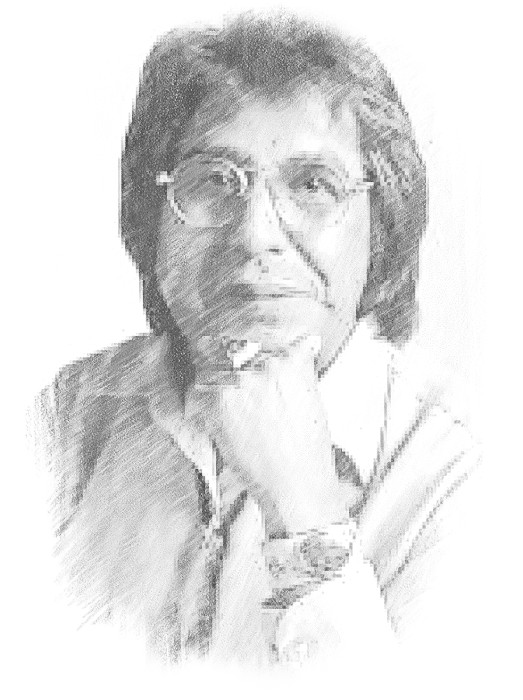
James Little
(b.1947)
Raised in a traditional Navajo family, most of his youth was spent in solitude herding his family’s flock of sheep. Almost totally deaf since birth, he was unable to distinguish words that were not spoken distinctly and within close range. At home, he watched his mother weave ancient designs into her rugs and his uncle work traditional symbols into his silver jewelry. Though he tried to listen intently, he struggled to understand as his father and uncle shared the traditional Navajo legends. Following a series of ear operations, he was fitted with hearing aids at age 19. The world suddenly became new and accessible. No longer content with herding, he told his family he wanted to learn to make jewelry and left home to study at the Navajo Community College under noted silversmith Kenneth Begay.
Little learned quickly and his skills flourished. He nurtured his dream and shaped it into reality and beyond. He designs and creates exquisite jewelry incorporating traditional Navajo elements and those of his mother’s rug designs into graceful contemporary pieces. A master of perfection, he pays attention to the minute details as demonstrated by the flawless finish of each piece. Noted among the top contemporary Indian artists, Little continues to seek new challenges and innovative ideas. He has been the recipient of numerous honors, awards and accolades and his work his highlighted in private as well as public collections.
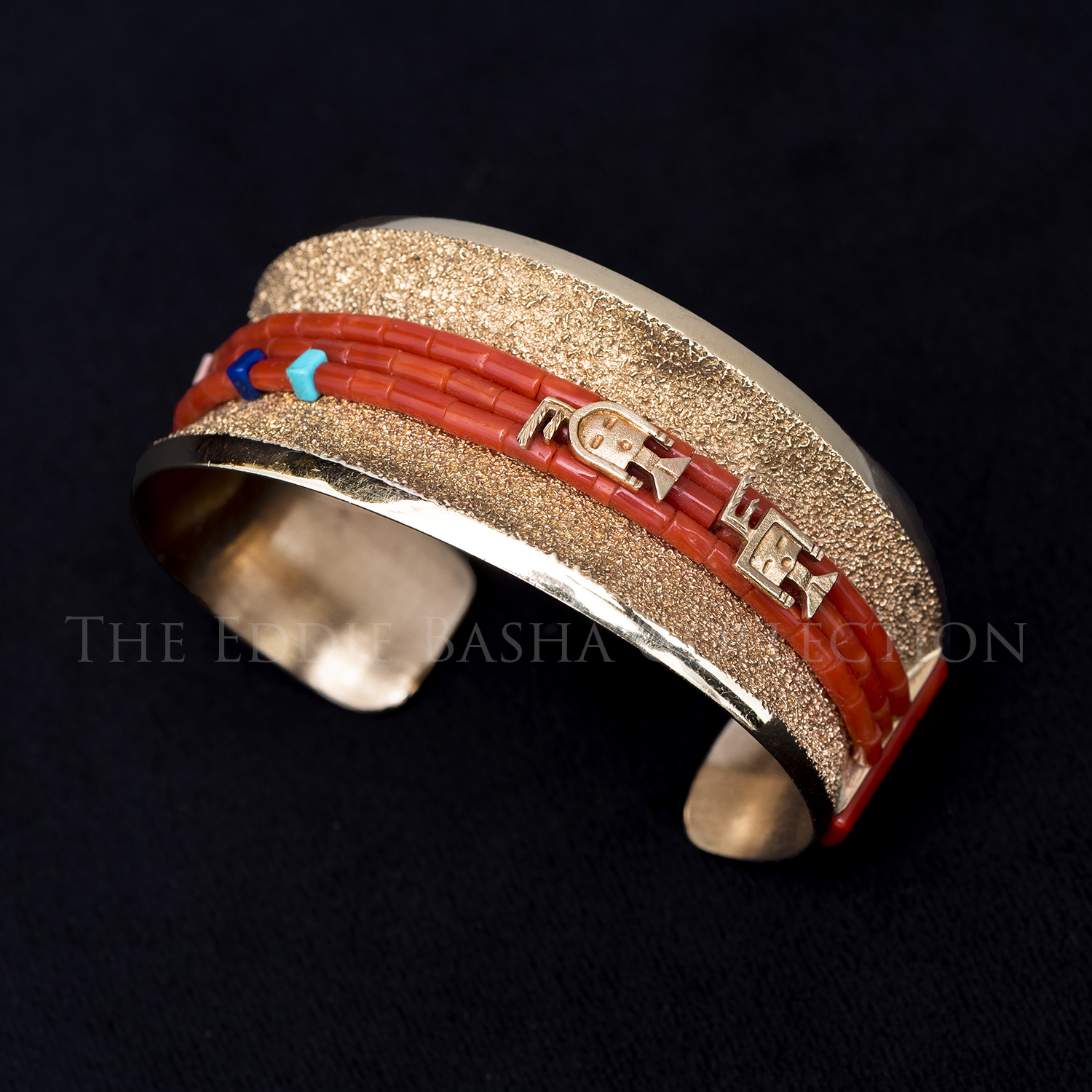
Bracelet
Artist: James Little (b.1947)
Description: Tofu Cast Gold, coral, turquoise, and lapis lazulijewelry
Raised in a traditional Navajo family, most of James Little’s youth was spent in solitude herding his family’s flock of sheep. Almost totally deaf since birth, he was unable to distinguish words that were not spoken distinctly and within close range. At home, he watched his mother weave ancient designs into her rugs and his uncle work traditional symbols into his silver jewelry. Though he tried to listen intently, he struggled to understand as his father and uncle shared the traditional Navajo legends. Following a series of ear operations, he was fitted with hearing aids at age 19. The world suddenly became new and accessible. No longer content with herding, he told his family he wanted to learn to make jewelry and left home to study at the Navajo Community College under noted silversmith Kenneth Begay.
Little learned quickly and his skills flourished. He nurtured his dream and shaped it into reality and beyond. A master of perfection, he pays attention to the minute details as demonstrated by the flawless finish of each piece. Noted among the top contemporary Indian artists, Little continues to seek new challenges and innovative ideas. He has been the recipient of numerous honors, awards and accolades and his work his highlighted in private as well as public collections. This tofu cast bracelet incorporates Little’s highly skilled goldsmith techniques, artful use of gemstones and respectful cultural references.
Ring & Bear Necklace
Artist: James Little (b.1947)
Description: Tufa Cast Gold & Diamondsjewelry
Both James Little pieces were made using an old Navajo technique created in the late 1800s called Tufa Casting. An impression is carved into compressed volcanic ash material that is found on the reservation. It is easier to carve than sandstone and its porous surface leaves a unique texture once the metal has cooled. Tufa casting is a labor-intensive process involving many steps.
First, a tufa stone is cut in half. The two halves are rubbed together to create a flush surface. A cone shaped hole, called a sprue hole, is carved at the top to allow the metal to be poured in. Additional holes carved along the sides allow air to escape. Next, the artist’s design is carved into the flat surface on the inside of the mold. The negative space carved away will be filled with molten silver or gold. The tufa stone is then carbonized with a torch and the two halve are bound together with clamps. The desired metal is melted and poured into the mold. Modern artists use gas torches or furnaces to melt their metal, but early silversmiths would fill a pottery container with coins and settle it into the embers of a fire until the metal was in a liquid state.
Once cooled, the hardened piece is taken out of the mold and the extra metal in the sprue hole is removed. The artist will carefully sand, clean and polish the design but will make sure to leave the porous texture from the tufa stone where intended. The last step is to shape the flat metal into its final form, such as the ring and the necklace pendant shown here.
Little’s work can be found in numerous private collections, museums and galleries worldwide.
Tufa Casting Info Source: Garland’s Indian Jewelry (Sedona, AZ)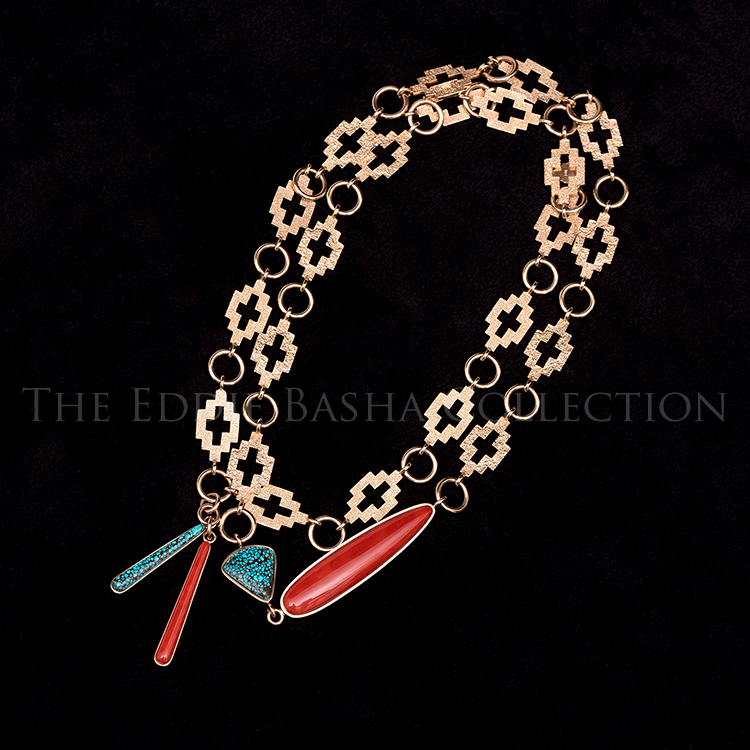
Necklace
Artist: James Little (b.1947)
Description: Gold, coral and turquoisejewelry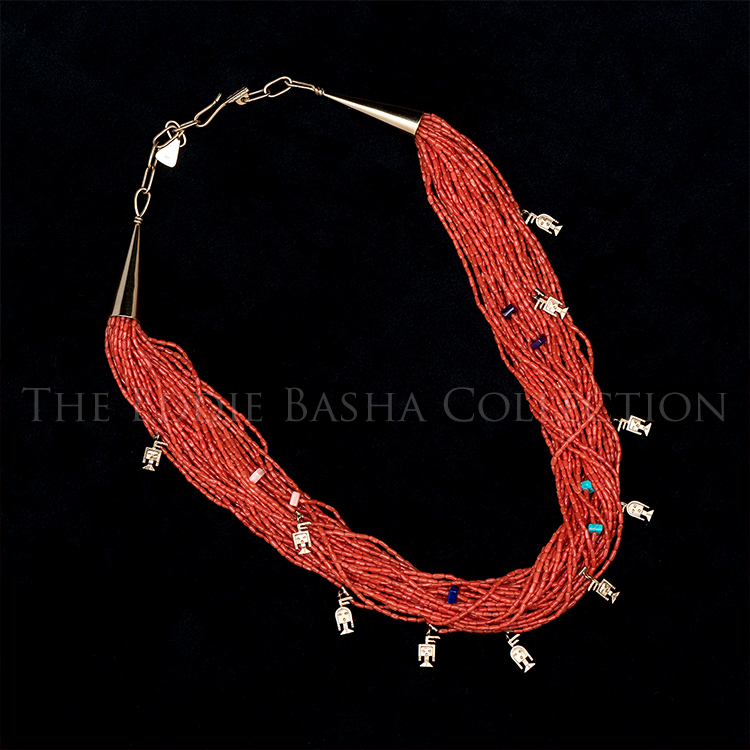
Necklace
Artist: James Little (b.1947)
Description: Gold, coral, turquoise, suglite and lapis lazulijewelry
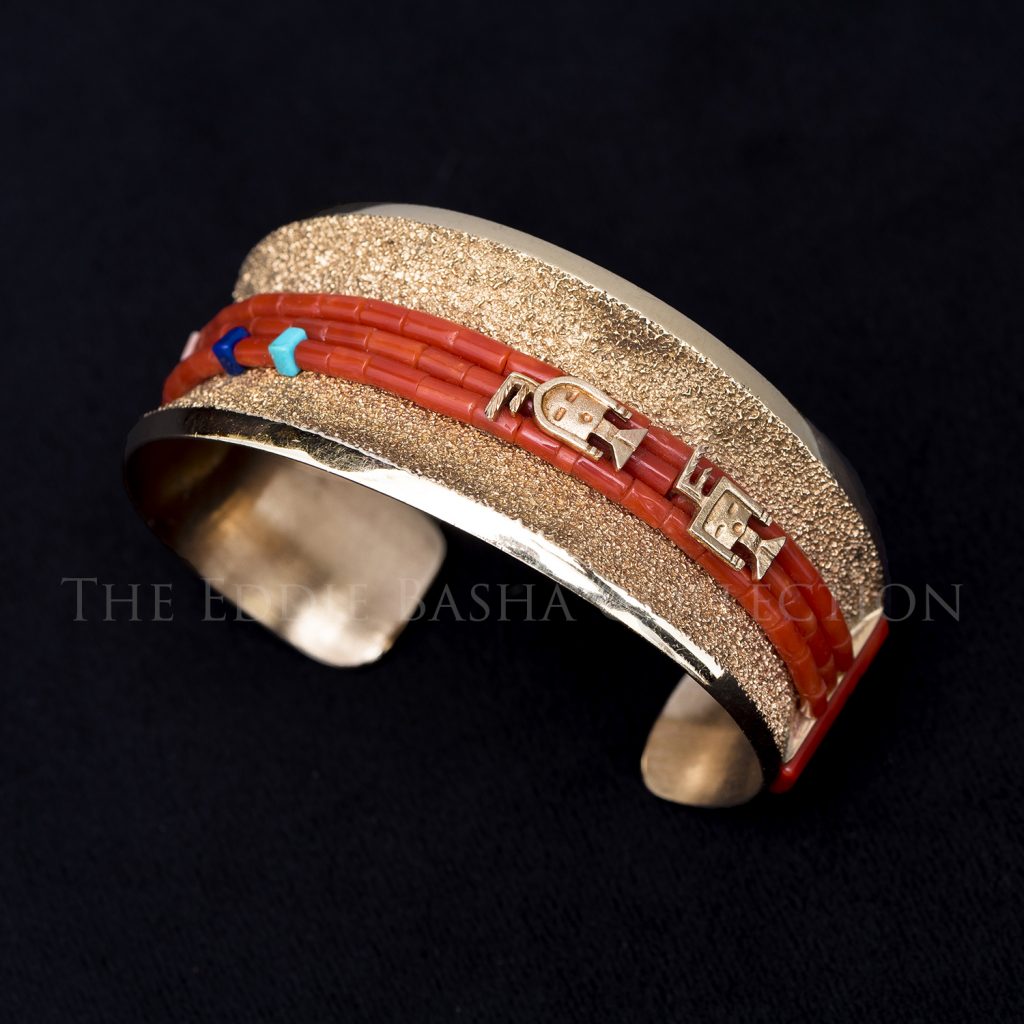 Tofu Cast Gold, coral, turquoise, and lapis lazuli
Tofu Cast Gold, coral, turquoise, and lapis lazuli Raised in a traditional Navajo family, most of James Little’s youth was spent in solitude herding his family’s flock of sheep. Almost totally deaf since birth, he was unable to distinguish words that were not spoken distinctly and within close range. At home, he watched his mother weave ancient designs into her rugs and his uncle work traditional symbols into his silver jewelry. Though he tried to listen intently, he struggled to understand as his father and uncle shared the traditional Navajo legends. Following a series of ear operations, he was fitted with hearing aids at age 19. The world suddenly became new and accessible. No longer content with herding, he told his family he wanted to learn to make jewelry and left home to study at the Navajo Community College under noted silversmith Kenneth Begay.
Little learned quickly and his skills flourished. He nurtured his dream and shaped it into reality and beyond. A master of perfection, he pays attention to the minute details as demonstrated by the flawless finish of each piece. Noted among the top contemporary Indian artists, Little continues to seek new challenges and innovative ideas. He has been the recipient of numerous honors, awards and accolades and his work his highlighted in private as well as public collections. This tofu cast bracelet incorporates Little’s highly skilled goldsmith techniques, artful use of gemstones and respectful cultural references.
Bracelet
Artist: James Little (b.1947)
Raised in a traditional Navajo family, most of James Little’s youth was spent in solitude herding his family’s flock of sheep. Almost totally deaf since birth, he was unable to distinguish words that were not spoken distinctly and within close range. At home, he watched his mother weave ancient designs into her rugs and his uncle work traditional symbols into his silver jewelry. Though he tried to listen intently, he struggled to understand as his father and uncle shared the traditional Navajo legends. Following a series of ear operations, he was fitted with hearing aids at age 19. The world suddenly became new and accessible. No longer content with herding, he told his family he wanted to learn to make jewelry and left home to study at the Navajo Community College under noted silversmith Kenneth Begay.
Little learned quickly and his skills flourished. He nurtured his dream and shaped it into reality and beyond. A master of perfection, he pays attention to the minute details as demonstrated by the flawless finish of each piece. Noted among the top contemporary Indian artists, Little continues to seek new challenges and innovative ideas. He has been the recipient of numerous honors, awards and accolades and his work his highlighted in private as well as public collections. This tofu cast bracelet incorporates Little’s highly skilled goldsmith techniques, artful use of gemstones and respectful cultural references.
 Tufa Cast Gold & Diamonds
Tufa Cast Gold & DiamondsBoth James Little pieces were made using an old Navajo technique created in the late 1800s called Tufa Casting. An impression is carved into compressed volcanic ash material that is found on the reservation. It is easier to carve than sandstone and its porous surface leaves a unique texture once the metal has cooled. Tufa casting is a labor-intensive process involving many steps.
First, a tufa stone is cut in half. The two halves are rubbed together to create a flush surface. A cone shaped hole, called a sprue hole, is carved at the top to allow the metal to be poured in. Additional holes carved along the sides allow air to escape. Next, the artist’s design is carved into the flat surface on the inside of the mold. The negative space carved away will be filled with molten silver or gold. The tufa stone is then carbonized with a torch and the two halve are bound together with clamps. The desired metal is melted and poured into the mold. Modern artists use gas torches or furnaces to melt their metal, but early silversmiths would fill a pottery container with coins and settle it into the embers of a fire until the metal was in a liquid state.
Once cooled, the hardened piece is taken out of the mold and the extra metal in the sprue hole is removed. The artist will carefully sand, clean and polish the design but will make sure to leave the porous texture from the tufa stone where intended. The last step is to shape the flat metal into its final form, such as the ring and the necklace pendant shown here.
Little’s work can be found in numerous private collections, museums and galleries worldwide.
Tufa Casting Info Source: Garland’s Indian Jewelry (Sedona, AZ)
Ring & Bear Necklace
Artist: James Little (b.1947)
Both James Little pieces were made using an old Navajo technique created in the late 1800s called Tufa Casting. An impression is carved into compressed volcanic ash material that is found on the reservation. It is easier to carve than sandstone and its porous surface leaves a unique texture once the metal has cooled. Tufa casting is a labor-intensive process involving many steps.
First, a tufa stone is cut in half. The two halves are rubbed together to create a flush surface. A cone shaped hole, called a sprue hole, is carved at the top to allow the metal to be poured in. Additional holes carved along the sides allow air to escape. Next, the artist’s design is carved into the flat surface on the inside of the mold. The negative space carved away will be filled with molten silver or gold. The tufa stone is then carbonized with a torch and the two halve are bound together with clamps. The desired metal is melted and poured into the mold. Modern artists use gas torches or furnaces to melt their metal, but early silversmiths would fill a pottery container with coins and settle it into the embers of a fire until the metal was in a liquid state.
Once cooled, the hardened piece is taken out of the mold and the extra metal in the sprue hole is removed. The artist will carefully sand, clean and polish the design but will make sure to leave the porous texture from the tufa stone where intended. The last step is to shape the flat metal into its final form, such as the ring and the necklace pendant shown here.
Little’s work can be found in numerous private collections, museums and galleries worldwide.
Tufa Casting Info Source: Garland’s Indian Jewelry (Sedona, AZ)